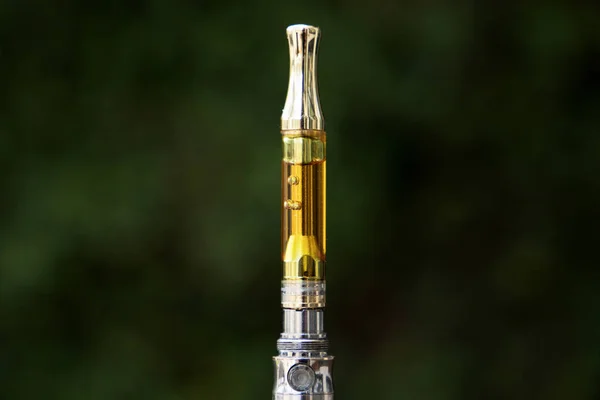Intro:
Image Source: (https://depositphotos.com/stock-photos/cannabis-vape.html)
Vaping cannabis involves inhaling the plant to experience its psychoactive effects or therapeutic benefits without combustion. Unlike smoking, vaporization occurs at lower temperatures, using convection and conduction heating methods that prevent burning and smoke production. Vapor offers a more flavorful and smoother experience compared to smoke. Understanding the origins, functionality, and advantages of cannabis vaping is essential for both new and experienced consumers seeking alternative consumption methods. Discover everything you need to know about vaping weed.
 History of Weed Pen
History of Weed Pen
Throughout our long-lasting relationship with cannabis, smoking has been the primary method of consumption. However, as time passed, humans explored alternative ways to consume this plant, such as tinctures, infused drinks like bhang, and concentrated forms like hash. Eventually, vaping emerged as a novel invention.
In recent decades, the popularity of vaping technology has surged, driven by our interest in finding healthier inhalation methods and the widespread use of tobacco and nicotine. The origins of electronic vaporizers can be traced back to Joseph Robinson, who filed one of the earliest patents for a vaporizer designed for plant compounds in 1927.
Continuing into the 20th century, other inventors embarked on endeavors to develop vaporization devices, including Jed Rose, the inventor of the nicotine patch, who aimed to minimize the negative health effects of tobacco. In 1993, Eagle Bill, a Cherokee medicine man, created the Shake and Vape, a pipe specifically designed for vaporizing cannabis.
How Does It Work?
Weed vaporizers utilize two main heating processes, conduction and convection, to vape dry flower and/or concentrates. Each method has its advantages and disadvantages.
Conduction: Conduction involves heating a substance through direct contact with a heat source, similar to how food cooks on a frying pan. In conduction-based weed vaporizers, an electrically heated ceramic or metal element serves as the heat source. For instance, in a Pax vaporizer, the chamber containing the flower or dabs is packed, and when heated, it comes into contact with the cannabis, creating vapor that can be inhaled. Many weed vaporizers, including vape pens, utilize conduction heating, which offers fast heat-up times but may not heat the material evenly since it may not come into contact with all of it. There is also a risk of burning the material due to direct contact.
Convection: Convection vaporizers, on the other hand, work indirectly. The heating element never touches the herb or concentrate directly. Instead, the device heats the air inside a chamber that surrounds the weed, resulting in the production of vapor. This can be likened to an oven that consistently circulates hot air, ensuring even distribution of heat throughout the product. Convection-based weed vaporizers often take longer to heat up but carry a lower risk of burning the weed.
Vape Pens and Atomizers: Vape pens and their cartridges primarily employ conduction heating. The cartridge, containing cannabis oil, houses an atomizer, which is a heating element such as a wick, ceramic coil, or metal plate. The battery device is connected to the cartridge, supplying power to the atomizer and heating it. As a result, the oil is vaporized, and the vapor can be inhaled through a mouthpiece.
The optimal temperatures for vaping flower and concentrates are often higher than what most people tend to use. It’s important to note that dabbing at 710ºF is not recommended, despite the misconception associated with the term “710.”
For vaping flower, it is advisable to set the temperature between 325-430ºF to achieve a satisfying experience without compromising the quality of your high. It is recommended to start at a lower temperature and gradually increase it until you find the temperature that suits your preferences, ensuring that you don’t overheat and damage the flower.
Concentrates contain less plant material than flower, allowing for higher temperatures ranging from 400-600ºF. However, some enthusiasts argue that temperatures above 500ºF may affect the flavor and the balance of cannabinoids and terpenes in the dabs. It’s important to note that there should be residue left in the concentrate vaporizer that can be wiped away. If you burn off all the residue, it is recommended to lower the temperature to avoid excessive heat.
When smoking a joint or using a bowl, the cannabis is eventually consumed and turns to ash. However, when vaping flower, the weed is not fully burned and transformed into ash due to lower temperatures. As a result, what remains is called already-vaped bud, or AVB. AVB typically has a brown appearance and feels dry, but it still retains some cannabinoids and terpenes. It can be utilized in various ways, such as for creating edibles, infusing oils, or even smoking. AVB holds considerable potential for further use despite its appearance and can contribute to alternative cannabis consumption methods.
Types of Weed Vaporisers:
Vape Pens: Vape pens are the most popular choice for cannabis vaping. They offer discretion, potency, portability, and affordability, making them a significant part of the cannabis market. However, it’s important to note that the prevalence of counterfeit vape cartridges in the illicit market poses risks. To ensure safety, it is recommended to purchase weed vape cartridges only from licensed dispensaries and reputable producers, as unregulated products may contain harmful substances. It is crucial to know how to identify genuine vape pens and find the best option for your needs.
Portable Vaporizers: Portable vaporizers have evolved significantly in the past decade. The introduction of the Pax 1 by Pax Labs in 2012 played a crucial role in their popularity. Initially designed for dry flower, newer models now also allow for concentrate vaporization at different temperatures. While Pax vaporizers utilize conduction heating, other portable vapes may employ convection or a combination of both methods.
Tabletop Vaporizers: Tabletop vaporizers are larger devices that are not meant for outdoor use as they require a power source such as electricity or batteries. One well-known example is the Volcano, which was invented in Germany and gained popularity in North America two decades ago. Most tabletop vaporizers utilize convection heating and are capable of producing a substantial amount of vapor from a small quantity of weed.
Are There Benefits?
The original motivation behind the invention of vaping was the belief that it provided a healthier alternative to smoking tobacco or cannabis, as it eliminated the inhalation of carcinogenic smoke. Presently, many individuals choose to vape because they perceive it as having lower health risks. Vaping offers a discreet and portable device that can be used without the lingering smell of weed smoke. Moreover, the use of controlled, low temperatures in vaping allows for the activation of cannabinoids and terpenes before they are burned off, potentially leading to stronger effects. Oil-based vape pens also provide higher potency compared to cannabis flower.
However, there are differing opinions on this matter. Cannabis smoke, like any burned substance, contains carcinogens that can affect lung function and immunity. Whether or not vaping is actually healthier than smoking is a topic of debate. A study conducted by the University of Michigan suggests that vaping weed may be more harmful than smoking weed or even cigarettes. However, due to the federal illegality of cannabis, conducting comprehensive research on the long-term effects of vaping remains challenging, and further investigation is necessary.


 History of Weed Pen
History of Weed Pen






0 Comments